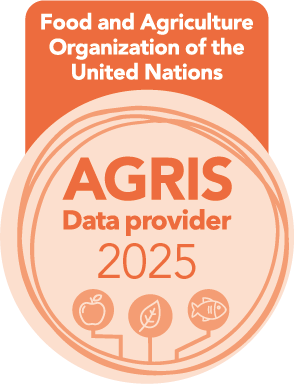Determinants in the Adoption of Climate Change Adaptation Strategies: Evidence from Wheat Farmers in Bundelkhand Region, India
DOI:
https://doi.org/10.26725/JEE.3.33.6647-6658Keywords:
Farmers Perception; Climate Adaptation; Rainfed Agriculture; Bundelkhand RegionAbstract
By using systematically collected field survey data of 200 farmers and binary logistic regression, results of this study reveals that wheat farmers of Bundelkhand, Uttar Pradesh, India are well-aware of changing climate and adjusting their farm practices to enhance climate resilience capacity. Farmers use their indigenous knowledge coupled with extension services provided by the government to diversify their occupation and cropping pattern as adaptation strategies. The Binary logistic regression results show that information on climate, access to institutional credit and having crop insurance motivate farmers to improved irrigation facilities. Further, farmers perceive that increase in temperature, decline in rainfall and water tables jointly change cropping pattern from the high water-intensive crop (wheat) to low water-intensive crop (chickpea) as a climate adaptation strategy. The study suggests developing a common platform for government services for the region. Community participation and regular training programmes in the sample villages are benefiting farmers to channelize their indigenous knowledge and optimize local resources, which leads to sustainable farming.References
Bryan, E., Deressa, T.T., Gbebouo, G.A. & Ringler, C. (2009) Adaptation to Climate Change in Ethiopia and South Africa: Option and Constraints. Environmental Science & Policy 12(4), 412-42
Fenton, A., Paavola, J. & Tallontire, A. (2015) Microfinance and Climate Change Adaptation: An overview of the current literature. Enterprise Development and Microfinance 26(3), 262-273.
GoI .(2008.) Inter-Ministerial Report on Drought Migration Strategies for Bundelkhand Region. Government of India, New Delhi, India.
Hansen, J., Marx, S. & Weber, E. (2004) The Role of Climate Perceptions, Exceptions, and Forecasts in Farmer Decision making: The Argentine Pampas and South Florida, IRI, Technical Report 04-01.
IPCC (2001) Climate change 2001: impacts, adaptation and vulnerability', Contribution of Working Group II to the Third Assessment Report of the Intergovernmental Panel on Climate Change, Cambridge University Press, Cambridge, UK, and New York, U.S.A.
IPCC (2014) Climate Change 2014: Impact, Adaptation and Vulnerability', Contribution of the Working Group II to the Fih Assessment Report of the Intergovernmental Panel on Climate Change, Geneva, Switzerland, 45-62.
Jatav, S.S., Sanatan, N., Surendra, M. & Sonali, N. (2021) Coping to Covid-19 in Uttar Pradesh, India: Evidence from NSSO 76 Round Data. Current Urban Studies 9(3), 206-217.
Jatav, S.S., Sanatan, N., Naveen P.S. & Kalu, N. (2022) Measuring and mapping food security status of Rajasthan, India: A District-level Analysis. Frontiers in Sustainable Food Systems 6, 1-17.
Maddison, D. (2006) The perception of an adaptation to climate change in Africa. CEEPA. Discussion paper No. 10, Centre for Environmental Economics and Policy in Africa, University of Pretoria, Pretoria.
Nhemachena, C. & Hassan, R. (2007) Micro-level Analysis of Farmers' Adaptation to Climate Change in Southern Africa. IFPRI Discussion Paper No. 00714. International Food Policy Research Institute, Washington, DC.
Panda, A. (2016) Exploring climate change perceptions, rainfall trends and perceived barriers to adaptation in a drought affected region in India. Natural Hazard 84(2), 777-796.
Pierro, R. & Desai, B. (2008) Climate insurance for the poor: challenges for targeting and participation. IDS Bullen, 39, 123-129.
Sanghi, A. & Mendelsohn, R. (2008) The impacts of global warming on farmers in Brazil and India. Global Environmental Change 18(4), 655-665.
Singh, S. & Sanatan S. (2014) Climate Change and Agriculture Production in India. European Academic Research 2(6), 12-30.
Singh, S.& Sanatan S. (2018) Land Inequality and Agricultural Sustainability in Uttar Pradesh, India: A Regional Analysis. Asian Journal of Science and Technology 9(11), 12-32.
Singh, S. (2019) Soil Health Security in India: Insights from Soil Health Card Data. Research Review International Journal of Multidisciplinary 4(3): 56-70.
Singh, S. (2020a) Bridging the gap between biophysical and social vulnerability in rural India: the community livelihood vulnerability approach. Area Development and Policy 5(4), 390-441.
Singh, S. (2020b) Farmers' perception of climate change and adaptation decisions: A micro-level analysis of farmers in Bundelkhand region, India. Ecological Indicators 116, 1-13.
Singh, S. (2020c) Assessing livelihood vulnerability of farmers’ in backward regions in India. Indian Journal of Agricultural Research 54(3), 222-226.
Singh, S. & Sanatan, N. (2020) Development of sustainable livelihood security index for different agro-climac zones of Uttar Pradesh. Journal of Rural Development 39(1), 110-129.
Singh, S. & Sanatan, N. (2021) Assessment of climate change impact on wheat yield in western dry region: A district-level analysis. Climate Change 6(21), 25-34.
Downloads
Published
How to Cite
Issue
Section
License
Copyright (c) 2021 https://creativecommons.org/licenses/by-nc-sa/4.0/

This work is licensed under a Creative Commons Attribution-NonCommercial-ShareAlike 4.0 International License.
Authors who publish with JEE agree to the following terms:
- Authors retain copyright and grant JEE right of first publication with the work simultaneously licensed under a Creative Commons Attribution License that allows others to share the work with an acknowledgement of the work's authorship and initial publication in this journal.
- Authors are able to enter into separate, additional contractual arrangements for the non-exclusive distribution of the journal's published version of the work (e.g., post it to an institutional repository or publish it in a book), with an acknowledgement of its initial publication in this journal.
- Authors are permitted and encouraged to post their work online (e.g., in institutional repositories or on their website) prior to and during the submission process, as it can lead to productive exchanges, as well as earlier and greater citation of published work (See The Effect of Open Access).
Extension Education Society
https://creativecommons.org/licenses/by-nc-sa/4.0/
This work is licensed under a Creative Commons Attribution-NonCommercial-ShareAlike 4.0 International License.













.png)

